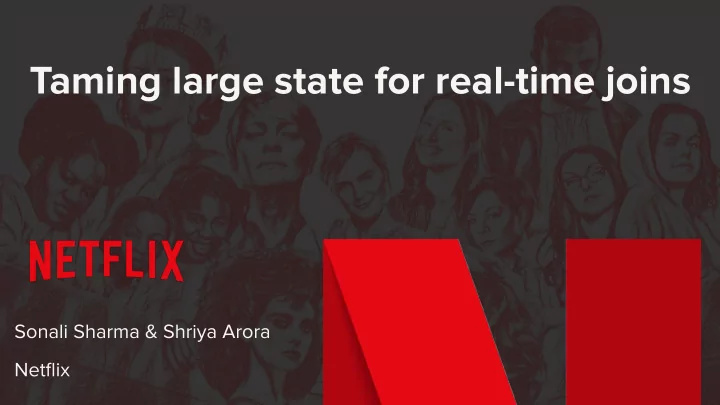

Taming large state for real-time joins Sonali Sharma & Shriya Arora Netflix
Waiting for your data be like ....
“I love waiting for my data” - said no stakeholder ever!
Sonali Sharma Shriya Arora - Senior Data engineer, Data Science and Engineering, Netflix - Build data products for personalization - Building low latency data pipelines - Deal with PB scale of data
Coming up in the next 40 minutes ● Use case for a stateful streaming pipeline ● Concept and Building blocks of streaming apps ● Data join in a streaming context (windows) ● Challenges in building low latency pipeline
Use case for streaming pipeline
Netflix Traffic 1 trillion events per day 100 PB of data stored on cloud
Recommendations everywhere!
Which artwork to show?
Signal: Take Fraction Play No play User A User B User C Take Fraction = 1 / 3 Profile B Profile C
Making a case for streaming ETL ` Real time Real time Faster training of Computational gains Reporting Alerting ML models
Recap: Use case ● Join Impression events with playback events in real time to calculate take fraction ● Train model faster and on fresher data ● Convert large batch data processing pipeline to a stateful streaming pipeline
Concepts and Building Blocks
Modern stream processing frameworks Qcon stream processing talks 2017
Bounded vs Unbounded Data Batch data at rest, hard boundaries Window Stream data is unbounded
Solution: Windows Windows split the stream into buckets of finite size, over which we can apply computations. stream.keyBy(...) .window(...) Group By [.trigger(...)] [.allowedLateness(...)] .reduce/aggregate/fold/apply() stream.join(otherStream) .where(<KeySelector>) Join .equalTo(<KeySelector>) .window(<WindowAssigner>) .apply(<JoinFunction>) T
Event time vs processing time 1 2 3 4 5 Clock Event time Processing time
Out-of-order and late-arriving events Event time windows Events from the Netflix apps 1st burst of events 2nd burst of events Ingestion pipeline Processing time windows
Solution: Watermark A watermark is a notion of input completeness with respect to event time. Watermarks act as a metric of progress when processing an unbounded data source.
Slowly changing dimensions Enriching stream with dimensional data API calls for ` enrichment Raw streams Enriched stream Combine streams Movie Metadata (Hive or data map)
Fault tolerance Newer records Older records Event time Checkpoint {n-1} Checkpoint {n} Checkpoint interval Checkpoint ● Snapshot of metadata and state of the app ● Helps in recovery
Check point interval Interval should have cover duration and pauses with buffer
Recap: Concepts and Building blocks ● Handling unbounded data, define boundaries using Windows ● Event time processing ● Handle out of order and late arriving events using Watermarks ● Enrich data in stream using external calls ● Fault tolerance is very important for streaming applications
Making a stream join work
Data Flow Architecture .keyBy Transform + Impression AssignTs Output stream Reduce Transform + .keyBy AssignTs Playback stream kafla By Source, Fair use, https://en.wikipedia.org/w/index.php?curid=47175041
Data Flow Architecture Transform + AssignTs Parse Filter AssignTs (raw ->T) (T-> T) (t.getTs()) By Source, Fair use, https://en.wikipedia.org/w/index.php?curid=47175041
Joining streams: Keyed Streams .keyBy DataStream KeyedStream .keyBy
Stream joins in Flink: Maintaining State Events need to be held in-memory for user-defined intervals ● of time for meaningful aggregations Data held in memory needs to be cleared when no longer ● needed A C Checkpoint RocksDB B
Aggregating streams: Windows Windows split the stream into buckets of finite size, over which we can apply computations. Stream volume: 200k /s/region Repeating values for same keys: 3-4
Aggregating streams Can the events be summarized as they come?
Updating state: CoProcess Function ValueState<T> K3,I K3,I K3,I K1,I K1,I K1 I + P + K3,P K4,P K1,P K1,P I + + P K3 P K4 Impressions Playback Composite Type
Stream joins in Flink: Updating State Timers ● Flink’s TimerService can be used to register callbacks for future ○ time instants. processElement() State onTimer() Timer service Aggregated elements
Recap .keyBy Transform + Impression AssignTs Output stream Summarize Transform + .keyBy AssignTs Playback stream kafla By Source, Fair use, https://en.wikipedia.org/w/index.php?curid=47175041
Challenges
Challenge: Data Correctness ● Trade-offs ○ Latency v/s completeness ● Duplicates ○ Most streaming systems are at-most-once ○ de-duplication explodes state ● Data validation ○ Real-time auditing of data ○ How to stop the incoming flow of bad data?
Challenge: Operations Visibility into event time progression
Challenge: Operations ● Visibility into state ● Monitoring checkpoints ● Periodic Savepoints ● Intercepting RocksDB metrics
Challenge: Data recovery ● Replaying from Kafka ○ Checkpoints contain offset information ○ Different streams have different volumes ● Replaying from Hive ○ Kafka retention is expensive ○ Easier for stateless applications
Solution: Replaying from Kafka ● Ingestion time filtering ○ Read all input streams from earliest ○ Netflix Kafka producer stamps processing time ○ Filter out events based on processing time stream.filter(e => e.ingestionTs > T2 && e.ingestionTs < T7 ) T1 T2 T3 T7 T8 T0 T4 T5 T6 T9 T10 System went down System came back up
Challenge: Region failovers ● Event time is dependent on incoming data ● Force moving the watermark via a maxInactivity parameter
Challenges we are working on State Schema Evolution ● Application level De-duplication ● Auto Scaling and recovery ● Replaying and Restating data ●
Finally
What sparked joy Fresher data for Personalization models ● Enhanced user experience ● Enable stakeholders for early decision making ● Save on storage and compute costs ● Real-time auditing and early detection of data gaps ●
Questions? Join us! @NetflixData
Recommend
More recommend